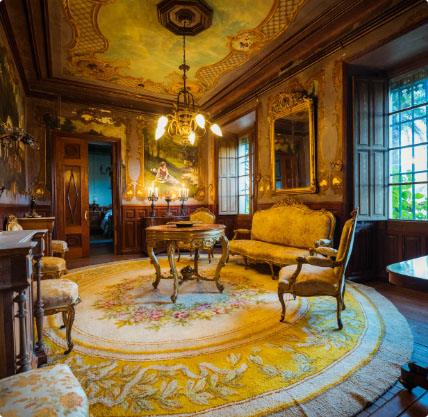The first references to the Pazo, its farm, vineyards and winery can be found in the family archives dating back to 1416.
The property was passed down from generation to generation until, in the mid-19th century, Don Manuel Batanero Montenegro and his wife, Doña Pastoriza Flórez de Losada y Quiroga, decided to renovate the old manor house, resulting in the pazo and gardens that we can enjoy today.
After an initial renovation, completed in 1869, the two towers were built in the last third of the 19th century, giving the complex a serene symmetry clearly inspired by colonial architecture.
The main façade of the manor house features large windows and balconies.
In the central section, above the main door and the coat of arms of Don Manuel and Doña Pastoriza, is another of the manor house’s treasures: the clock dating from 1869, which was made in London by José Rodríguez Losada. The clock at the Puerta del Sol in Madrid also came from his workshop.

In the last third of the 19th century, the historic terraced gardens of significant botanical value were completed, along with the hydraulic network that allowed water to be carried from the springs in the upper part of the estate to the entire property using a network of canals, mines, wells, cisterns and fountains.

Inside the main building, highlights include the chapel and family pantheon dedicated to the Virgin of the Divine Shepherdess and Saint Blaise, the large dining room, the bishop’s hall, the gallery, the billiard room and the cellar, which houses original bottles of wine and liqueur from the 19th century…


There is also a coach house on the estate, where the wine cellar is temporarily located, and other buildings that have been standing since the 16th century, if not earlier: the impressive original wine cellar with a surface area of 350 m2 and 11-metre-high walls, the wood-fired oven, the stables, the barn, the woodshed, and the extraordinary stone staircase that provides entry to El Pazo, dating back to the end of the 17th century.
In the mill building, a coat of arms of dating back to the beginning of the 16th century is still visible. It pertains to Captain Álvaro de Losada y Somoza and his wife María Valcárcel de Quiroga y Balboa and incorporates the six dice and the fleur-de-lis of the Somoza family, the flagstone over two lizards of the Losadas, the tree with four stakes of the Valcárcel de Quirogas, and the lion rampant in water of the Balboas.
This coat of arms was adopted by 19th-century descendant Doña Pastoriza, and now forms part of the Pazo de La Cuesta brand
Year of the first documented reference to wine production at Pazo de la Cuesta.

First inventory of winemaking activity at Pazo de la Cuesta, as detailed in Álvaro de Gon y Somoza’s will, and inherited by his grandson, Captain Álvaro de Losada y Somoza.
Manuel Batanero de Montenegro sells El Pazo’s wines under the brand “Palacio de la Cuesta,” making it the first winery in Northern Spain to label its wines.

Mrs. Pastoriza Florez de Losada and Mr. Manuel Batanero de Montenegro complete the first phase of rehabilitation of the Pazo.
The year of the first vintage preserved in the historic wine collection.
Manuel and Pastoriza’s great-great-grandson Manuel Bellod Álvarez de Lorenzana takes on the project to renovate the El Pazo de la Cuesta winery and recover its historic vineyards.
The ambitious restoration project of the Pazo was completed after four years of work. A Cova, the imposing half-buried cellar from the 16th century, where, after more than a hundred years, the wines of Pazo de la Cuesta are aged again, is also restored.

In 2020, Manuel and Pastoriza’s great-great-grandson, Manuel Bellod Álvarez de Lorenzana, committed to restoring El Pazo and its vineyards and returning its wines to their former prestige.
Significant improvements are currently being made to the estate, including the restoration of the original 16th century wine cellar, the original coach house, the wood-fired oven, the mill, and the waterwheels for the water supply network.
And of course, the gardens and vineyards are also being restored, once again bearing fruit from two century-old vines, fruit, and olive trees.




Pazo de La Cuesta has belonged to the same family since it was founded in the 16th century: fourteen generations reigned over by the Flórez de Losadas, Flórez de Quiñones, Somozas, Quirogas, Pugas, Montenegros, Bataneros, Bellods, and Álvarez de Lorenzanas, among others.